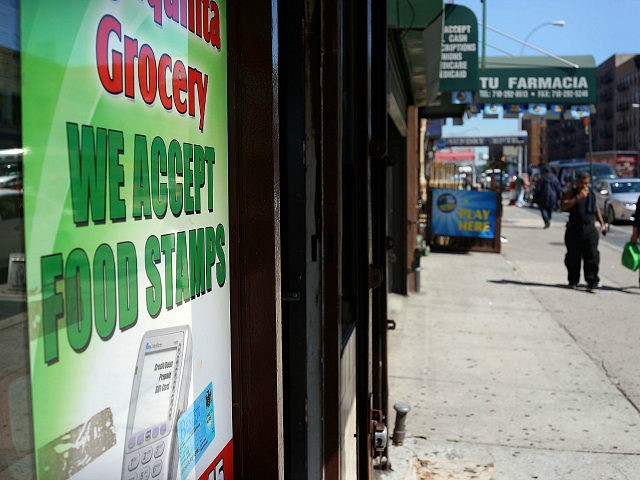Four million people dropped off the food stamp rolls in one month, according to the latest numbers on food stamp enrollment from the U.S. Department of Agriculture (USDA).
The latest USDA data show that the number of participants in the Supplemental Nutrition Assistance Program (SNAP), the government program that administers food stamps, dropped from 45,666,795 in October 2017 to 41,658,868 in November 2017 — a staggering decrease of 4,007,927 over one month.
Even though there was a temporary spike in enrollment, mostly concentrated in a few states that caused the national average of food stamp enrollment to spike, nationwide enrollment in the program as a whole is still on a steady decline.
Enrollment in the program sharply increased by 3.5 million during the first month of fiscal year (FY) 2018 (October 2017) mostly due to heavy increases in temporary SNAP enrollment in hurricane-affected states such as Florida and Texas.
In Florida alone, food stamp participation soared by 2.5 million from September to October due to the state administering Disaster Supplemental Nutrition Assistance Program (D-SNAP) benefits to poor residents affected by Hurricane Irma.
The USDA’s Food and Nutrition Service approved Florida’s request to administer these special D-SNAP benefits beginning September 10, 2017.
A spokesperson for Florida’s Department of Children and Families (DCF) — the program that administers food stamp benefits in Florida — confirmed with Breitbart News that the dramatic increase in SNAP enrollment in the state was due to disaster relief, but that most food stamp recipients were not normal beneficiaries of the food stamp program.
“The dramatic increase in SNAP recipients in the fall was related to the state’s administration of the federal disaster SNAP program following the impact of Hurricane Irma. To qualify for the federal disaster food assistance program, individuals must have lived or worked in one of the 48 declared counties on September 5, and NOT be a customer in the regular food assistance program,” said DCF Communications Director Jessica Sims.
Sims added that DCF handed out D-SNAP benefits totaling more than $1 billion to 3.1 million people in the months following Hurricane Irma, but the state curtailed its D-SNAP benefit program on December 3.
The sharp decline in food stamp enrollment over one month reflects how states like Florida have curtailed their temporary food stamp benefit programs for those affected by natural disasters.
But it also highlights an ongoing downward trend in food stamp enrollment that has been going on for several years since state legislatures enacted welfare reform measures designed to get people back into the workforce.
The Trump administration announced that it would adopt some of these state welfare reform measures — such as requiring food stamp recipients to work a certain number of hours per week — and implement them at the federal level, causing nationwide food stamp enrollment to plunge even further.
Over the past year since President Donald Trump took office, enrollment in SNAP dropped by two million. The latest food stamp numbers show that the downward trend over the past year — and every year after 2013 — is continuing.

COMMENTS
Please let us know if you're having issues with commenting.